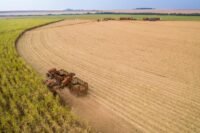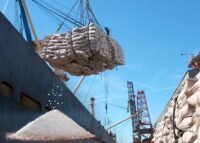The discovery of N-fixing microorganisms in both rhizosphere and root surface by the researcher J. Dobereiner in 1961 allowed the subject to be driven by other researchers, even in the present time of 2016, when they identified a great diversity of N-fixing bacteria in the culture as they were dependent on sugarcane varieties. However, under field conditions, biological fixation has aroused controversy, since even when confirmed the positive effect of the plant on the development of bacteria there is no evidence that it can guarantee the supply of N as observed (Dobereiner, 1992), including in others countries such as Australia and South Africa. In addition, researchers from these countries have emphasized that the biological fixation of N in cane is not a significant and reliable source of this nutrient, although N-fixing bacteria have been isolated in the field (for details see: Vitti et al , In Cana de Açúcar, Dinardo-Miranda et al., 2008)

In Australia Biggs et al. (2000), using the 15 N technique, observed that of the eight experiments tested only one resulted, but questionable, because the researchers attribute that specific situation of the soil tested may have contributed to the increase in reporting. The contribution of biological N fixation has been extremely variable, but most authors attribute values in the 7 kg N range (Ruschel et al., 1992).
PARCELAMENTO DO N EM CANA PLANTA
The action of N mineralization of the soil OM and probably of the fixing bacteria in the cane plantation, influenced the N response varying from 0 to 60 kg / ha. Certainly, such factors may also influence the installment plan. The work related to this theme is also in great number, most of which emphasize that the results obtained confirm the absence of response to the N, in spite of the texture, which allows to recommend the application of the fertilizer in a single operation.
Penatti and Donzelli (2000), working with 10 varieties, planted with 30 kg / ha of N and 45 kg in cover in clayey soil of the region of Ourinhos, and in average texture in the region of Araraquara, with a total of 75 kg / ha of N and did not obtain a response to N plotting. The average yield in Ourinhos was 137 t / ha, with 30 kg of N at the planting and 142 t / ha at the cover, and at Araraquara with 131 t / ha at planting and 132 t / ha in coverage.
The same authors, in 2000, working with 16 varieties in the region of Ribeirão Preto, in clay soil, performed the same treatments as the previous ones and did not obtain a response to the parceling, with a mean of 175 t / ha with 30 kg / ha of N in the planting, and 173 t / ha with 45 kg / ha in coverage. In a classic work on the subject, Penatti (2001) installed two experiments in medium to sandy soil (Catanduva and São Jose de Estiva Uses), with 12 varieties and three forms of fertilization, in kg / ha, as follows: T1- 60-150-150 (N-P205-K20 applied to the groove); T2-30-150-150 in the groove + 30 kg of N in coverage; T3- 150 kg of P205 in the groove + 60-00-150 in coverage. The average of the results indicated that there was no significant difference for the sugarcane productivity as well as the Pol. Cana as a function of the applied system. The agroindustrial contribution margin was similar for the treatments and, therefore, indicated greater ease for the total application of the nutrients in the planting groove.
In 2002 Penatti and Forti, working with 10 varieties in clay soil where they applied N content in the planting in kg / ha from 0 to 90, as well as the parcelings of 30 + 30 kg / ha of N, observed that at the end of the experiment there was no significant effect of N plotting. However, they analyzed a positive effect on the N content of four varieties, while in the other 6 there was no response (Table 1).

After 2005, and due to the changes in agricultural operations, mainly with the harvesting blocks, mechanized cutting and expense containment, most of the mills eliminated the controlled parcels of the experiments and with that the quality was much lost information. Currently, biometrics has been used to evaluate the experiments with all the implications related to the system. At the same time, a number of new products have been offered to the market for foliar application, containing micro complexes associated or not with PK, hormonal products, humic acids, amino acids, liquid forms of N with or without companions of other nutrients, capped or not with humic acids, among others.
With the biometrics information, productivity has been increased in the range of 4 to 8 t / ha and, possibly, higher values. Depending on the product the final cost has been in the range of 2 to 3 t of sugarcane, which causes users to risk more in the applications. Many of the companies of the products use of foliar analyzes to elaborate the information of that to apply, but with dubious analytical results, placing in disdain the suppliers. Within this context a fact has drawn attention: in the past the productivity variations in foliar application seldom gave results and currently practically everything that is applied has given result. How to explain? Eventually, and in certain situations, as a less-nourished reed, aerial application is positive and should be maintained.
In addition, it must be taken into account that in raw cane 25% to 35% of the micro nutrients are in the straw and do not return for at least a few years to the system and therefore aerial applications of micros have worked. However, once the soil is adequately recovered chemically, including with micro in appreciable doses, for cane plant or ratoon aerial application is not justified.
In a complex soil environment, where chemical, physical and biological factors interact continuously influencing the other soil conditions, such as temperature, humidity, reaction, etc., it can be seen that the bacterial community is strongly governed by such factors, affecting the composition of the soil. In this context there is influence of both N-fixing bacteria and pure and simple mineralization. The internal N cycle in soil is the controller of N availability for plant nutrition, regardless of its origin.
FEW STUDIES

Despite its great importance, the mineralization of N has few studies on the microbial processes of mineralization, N transformation in the soil, mainly in Brazil, and the majority of research efforts have been directed to the study of the biological fixation of N2. According to Victoria, 1992, the most advisable procedure for the study of soil N mineralization would be to focus, in spite of the difficulties, on the ammonification and nitrification processes. In summary, the main points related to the theme:
1) As long as there is no evolution of the experiments and greater understanding of the action of OM on the release of N, the amount to be applied of the N-fertilizer in cane plant and rye is summarized in Table 3;
2) The fractionation of N is not justified, as is leaching, except in specific cases. On aerial application of other products would only be justified if the soil is below the need of the crop. The balance of N applied via fertilizer and not used by the crop in the plantation would be used in the later soqueira;
3) Biological fixation due to diazotrophic bacteria, despite occurring in the soil, has not presented the necessary performance in the fixation of N2 to supply the demands of the crop, either in the cane plant or in the ratoon. Positive response to inoculation of bacteria has been indicated to be dependent on the cane variety, which greatly hampers large-scale applications. The inoculation of N-fixing bacteria in cane has not provided the necessary security for users, and this knowledge is still confined to the research area.
* José Luiz Ioriatti Demattê is a full professor and former head of the Department of Soil and Plant Nutrition of Esalq / USP













